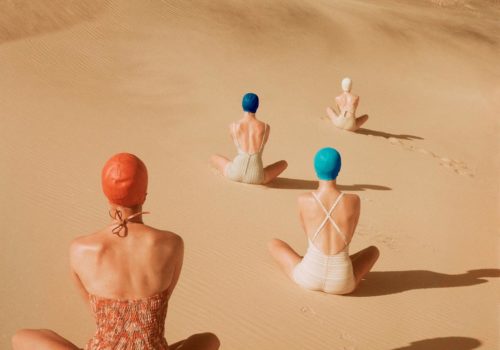Fashion photographs – glamorous, provocative, beautiful, accomplished, magical – have always been associated with some of the most famous names in the history of photography, such as Edward Steichen, Horst P. Horst, Erwin Blumenfeld, Irving Penn, Guy Bourdin, William Klein, Helmut Newton and Herb Ritts. This has been the case since the appearance of fashion photography in magazines in the early years of the 20th century. Fashion photographs are part of our visual culture. Each image tells a story and invites us to engage with it in a pleasurable way, but it also encapsulates something of the tastes, the aspirations and the dreams of its time. Glamour, elegance and sexiness are concepts that are endlessly redefined. During the 1990s in particular, they went hand in hand with their opposites – the ugly, the shocking, the unsightly and the misshapen – as reflected by both fashion designers and photographers alike. ‘Fashion photographs inevitably become commentaries on the idea of the fashionable,’ wrote Susan Sontag. And the ‘idea’ evolves according to the times, the medium and the viewer. It depends on these whether the attitude is more important or the clothing itself and whether the trend is towards mainstream or subculture, attractiveness or blatant sexuality. Fashion photography is often paradoxical: it is both creative and commercial – produced to order but at the same time generating progressive, experimental, artistic images – and it represents both haute couture and popular culture. Fashion photography may be regarded as an art form, but it is still an industry (a visual industry) that services another (whether fashion, ready-to-wear, accessories or cosmetics).
Early generations of fashion photographers retained some control over the production of their images, but their creations gradually came under the control of other decision-makers: the editors, of course, but also the advertisers promoting prestigious brands. The control of the photographer is often limited: the subject matter is given, the model and the location are chosen in advance. Financial considerations are such that they frequently outweigh artistic ones. The magazine’s most important issues are the object of scrupulous attention and the photographers’ contracts are drawn up months in advance. Editors at top-selling magazines have grown wary of taking risks with newcomers and it is no longer an easy matter for a beginner to find a way in.
Fashion photography is firmly anchored within the system of consumption, capitalism and what the Marxist theorist and filmmaker Guy Debord calls ‘spectacle’. Aesthetically speaking, a magazine constructs a visual story. The styles adopted by the photographers help to shape the history of magazines. Fashion photography does not fall either side of the art-or-commerce divide. It reflects the society and the culture of its times. It is about elegance, but it is also about people. It uses a language whose words have multiple meanings and creates what has been described as a ‘hybrid scenario’.Fashion images are not intended to be timeless: they mirror the concerns and aspirations of their age – the Zeitgeist.
When we look at how fashion photography has developed over the last century, it becomes clear that the creative impulse has survived a system of ever-tighter controls. As the fashion industry and its economy have expanded, photographers have continued to demonstrate their capacity for invention and innovation, and this despite the growing influence of stylists, advertisers and retouchers. They have shown that it is possible to develop as a fashion photographer at the creative and artistic level despite the restrictions imposed upon them. Fashion photographers produce a considerable number of images over the course of their career and – especially if this career spans twenty, thirty or forty years – are obliged to be inventive if they wish to avoid repetition. This is not a philosophy that can be learnt over time: it applies from the very start. And it is thanks to such early and abiding genius that timeless fashion images are created – images that are more than the product of a single fashion moment. Cecil Beaton said that there were two types of fashion photographer: those who chase the fleeting image and those who are mindful of posterity.Unquestionably, the photographers whose works are featured in this exhibition belong to the second category.
The legendary publisher Condé Nast recognized the sociological dimension and the tremendous effective force of fashion photography very early on. With his keen sense for discovering new talents he promoted careers and in this way had a long-term influence on a whole artistic genre. By surrounding himself with great artists, Condé Nast placed Vogue, in addition to his other magazines (most notably Vanity Fair and Glamour, as well as the foreign editions of Vogue), at the forefront of the photographic avantgarde. The Condé Nast studios in New York, Paris and London were laboratories of creativity, employing artists eager to capture and show off the gems of haute couture. This is still the case today, most notably at Vogue Italia in Milan. The exhibition looks at 100 years of fashion photography. Carefully selected from the Condé Condé Nast archives in New York, Paris, London, and Milan, more than 150 mostly vintage prints and original magazines provide a unique opportunity to see the work of over 80 photographers right at the outset of their careers who went on to become the biggest names in the history of fashion photography.
















